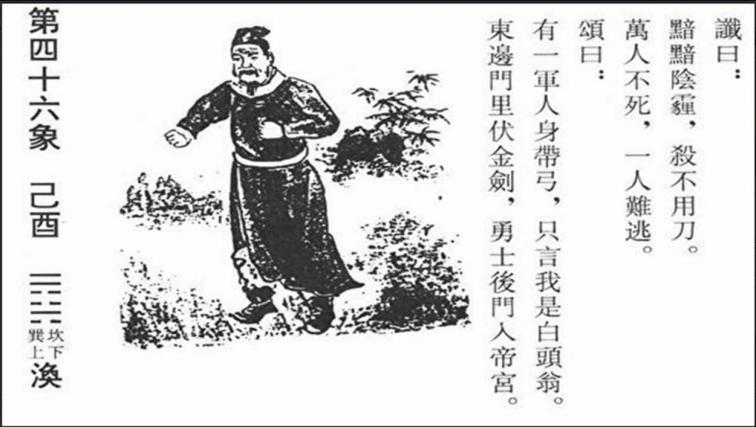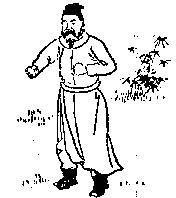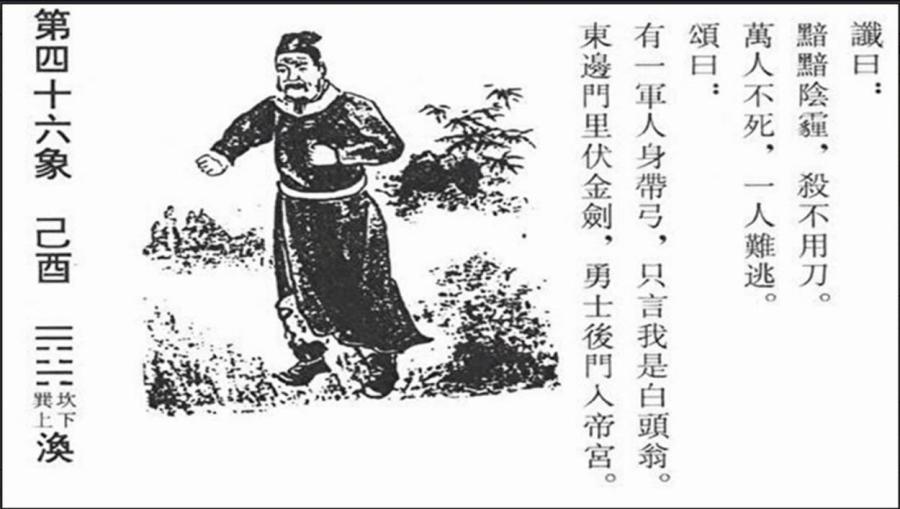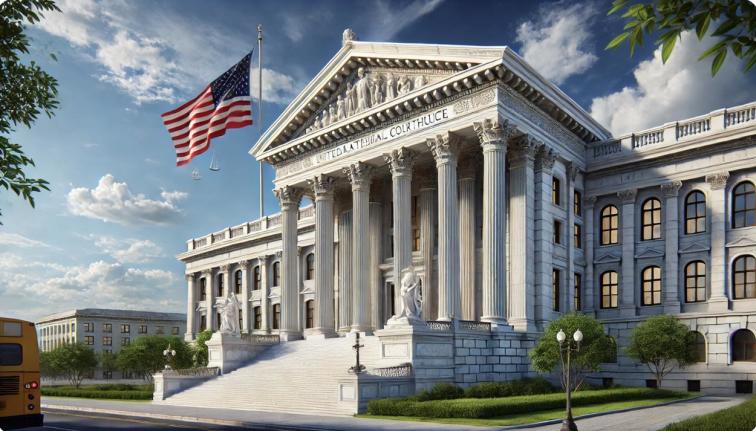Dajiyuan Version of the Prophetic Image from "Tui Bei Tu" (Source: Dajiyuan)
[People News] The Tui Bei Tu (《推背圖》) is said to have been commissioned by Tang Emperor Taizong and co-authored by astronomer Li Chunfeng and physiognomist Yuan Tiangang to predict China’s destiny. The most widely circulated version today was published in the 4th year of the Republic of China (1915), annotated by the Ming–Qing transitional thinker Jin Shengtan. It consists of 60 prophetic images, each containing a drawing, four lines of prophecy (chen), four lines of verse (song), and a commentary by Jin Shengtan. Starting with "From Pangu to Xi Yi," it ends with "Better push back and retire." Based on current events, Image 46 of the Tui Bei Tu appears to predict a bloody disaster.
1. Comparison Between The Epoch Times and CCP Versions of Image 46
Prophecy (Chen):
Dark and gloomy, a killing without knives.
Ten thousand survive, but one cannot escape.
Verse (Song):
A soldier with a bow proclaims: I’m a white-headed man.
A golden sword lies hidden in the eastern gate,
A warrior enters the imperial palace from the rear.
Dajiyuan Version of the Image:
 !
!
Dajiyuan Version of the Prophetic Image from "Tui Bei Tu" (Source: Dajiyuan)
The CCP Version of the Image:

Chinese Communist Party version of the prophetic image (online image)
Upon comparison, it is clear that the CCP version has omitted many details. These omitted parts must be the key elements the regime wants to conceal.
2. Heavenly Stems, Earthly Branches, and Hexagram Analysis
The image is marked “Ji You” (己酉), corresponding to the 46th image. In the Chinese metaphysical system, Ji (己) represents yin earth, You (酉) represents yin metal.
This indicates a weakening element ("child thrives, mother declines") and suggests self-destruction and lack of strength. The corresponding I Ching hexagram is "Dispersal" (渙), symbolising scattering and disunity.
3. Decoding the Image
Old Man and Demonic Stone: Between the legs of the old man is a stone shaped like a demon, symbolising the Chinese Communist Party (CCP) as a demonic force.
"71" on Forehead: The numbers "71" (July 1) on the man's forehead refer to the founding date of the CCP—another indicator that the man represents the Party.
Black Robe: The man originally wears a black robe (altered to white in the CCP version). Black is the colour of water in Chinese metaphysics; Xi Jinping was born in the Year of the Water Snake (1953), associated with black. The robe's colour change suggests intentional concealment.
Hat with Jade: The old man wears a hat with a jade piece, symbolising high official status. In ancient China, only high-ranking ministers wore such hats. Xi Jinping, during his youth, was nicknamed "Xi Zheng" (meaning “Xi the upright”). This implies the old man symbolises Xi.
Four Hills: Represent four opposing forces or factions.
U.S.-based China analyst Willy Lam identified four major factions challenging Xi in a 2025 Jamestown Foundation report:
-
Retired Politburo Standing Committee members – the "Elder Party"
-
Overseas Red Second Generation – children of founding CCP leaders living abroad
-
Senior CCP officials – including Zhang Youxia, Zhao Leji, He Lifeng, and Li Qiang
-
The common people – the masses left without options
Left-Front Hill: People climbing—symbolising party officials like Zhang Youxia and Zhao Leji facing purges, possibly retaliating against Xi.
Right-Front Hill: Behind the man—symbolising the Elder Party (e.g., Jiang Zemin, Zeng Qinghong). They are both allies and enemies of Xi.
Connection by Demon Stone: The demon stone connects both front hills, showing all are entangled with the CCP’s demonic nature.
Left-Rear Hill: Depicts labour—symbolising ordinary people.
Right-rear hill: The hill is black, symbolising the overseas "Red Second Generation" (children of early CCP leaders). Though they haven’t participated in politics, they carry the CCP's bloodline, hence the hill's dark colour. Bamboo grows on the hill — the word "bamboo" (竹) is a homophone for "execute" (誅), implying a sense of “killing” or punishment.
Left-front and left-rear opposition symbolise the current conflict between officials and the common people.
Right-front and right-rear opposition suggests tensions between the Elder Party and the overseas Red Second Generation. The latter believes the former has stolen what rightfully belonged to them.
The left-front and right-front hills are connected by the demonic stone, while the left-rear and right-rear hills are not connected, indicating that, in reality, the Red Second Generation has no real ties with the ordinary Chinese people.
4. Decoding the Prophecy Text
Dark and gloomy, a killing without knives.
Ten thousand survive, but one cannot escape.
-
“Dark and gloomy” reflects the ominous atmosphere. On July 7, Xi visited Yangquan, Shanxi to commemorate the Hundred Regiments Offensive—it was a dark, cloudy day, symbolising the storm within the regime.
-
“Killing without knives” – Refers to political purges and assassinations without literal weapons—possibly death by illness, poison, or internal coups.
-
“Ten thousand do not die” – The suffering public and officials all hope to survive Xi's rule.
-
“One cannot escape” – Refers to Xi Jinping, often called "the One Supreme" (Yi Zun). This term comes from Records of the Grand Historian: “Now that the emperor rules the world, he alone defines right and wrong.”
But Xi’s version uses autocracy, not morality, to define his rule, putting him in opposition to the entire world.
5. Decoding the Verse
A soldier with a bow says: I am the white-headed man.
A golden sword lies hidden in the eastern gate,
A warrior enters the imperial palace from the rear.
-
“Soldier with a bow” – Likely represents Zhang Youxia, or could symbolise Li Qiang and the late Li Keqiang. This line hints that Xi has lost control of the military.
-
“White-headed man” – According to analysis by The Mysterious Unsolved, replacing the "white" (白) character head with "public" (公) gives "Xi" (习). Also, the U.S. is symbolised by the white-headed eagle, implying American involvement.
-
“Golden sword in the east” – “East” refers to the East China Sea and Kinmen, suggesting a brewing Taiwan Strait crisis.
-
“Warrior enters from the rear” – Analyst Wen Zhao believes this hints at a Russian betrayal.
On July 12, commentator Yuan Hongbing revealed that in May, a Chinese diplomat defected to Russia and exposed the CCP’s strategic plans. If Russia is defeated, the CCP has two plans: 1. Rebuild Russia under Chinese dominance. 2. Seize Russia’s Far East up to the Ural Mountains if the U.S. occupies its European territory. This would turn Russia into China’s enemy.
The prophetic verse (讖語) and prophetic image (讖圖) represent predictions, while the ode (頌語), meaning "virtuous praise and prayer," carries a tone of admonition or advice.
If Xi Jinping were to calm and guide the four major forces internally, avoid provoking conflicts, refrain from launching a military attack on Taiwan externally, maintain diplomatic ties without antagonising the U.S. or Russia, and not deploy the military domestically, then he might not find himself in such a dangerous situation. Unfortunately, the prophecy appears to be coming true, one step at a time.
(Originally published by People News)











News magazine bootstrap themes!
I like this themes, fast loading and look profesional
Thank you Carlos!
You're welcome!
Please support me with give positive rating!
Yes Sure!